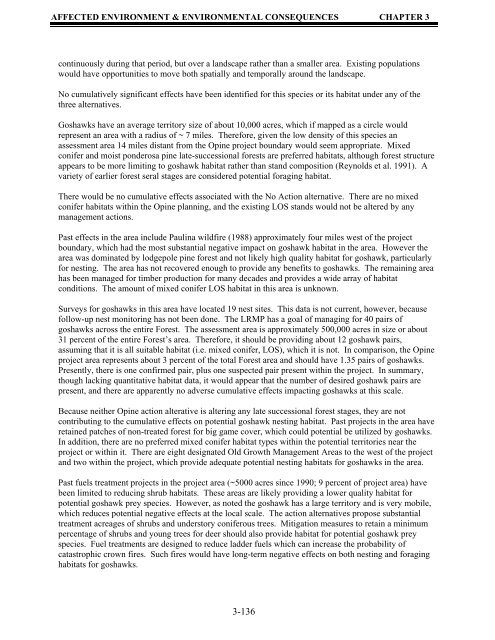Environmental Assessment
Environmental Assessment
Environmental Assessment
You also want an ePaper? Increase the reach of your titles
YUMPU automatically turns print PDFs into web optimized ePapers that Google loves.
AFFECTED ENVIRONMENT & ENVIRONMENTAL CONSEQUENCES CHAPTER 3<br />
continuously during that period, but over a landscape rather than a smaller area. Existing populations<br />
would have opportunities to move both spatially and temporally around the landscape.<br />
No cumulatively significant effects have been identified for this species or its habitat under any of the<br />
three alternatives.<br />
Goshawks have an average territory size of about 10,000 acres, which if mapped as a circle would<br />
represent an area with a radius of ~ 7 miles. Therefore, given the low density of this species an<br />
assessment area 14 miles distant from the Opine project boundary would seem appropriate. Mixed<br />
conifer and moist ponderosa pine late-successional forests are preferred habitats, although forest structure<br />
appears to be more limiting to goshawk habitat rather than stand composition (Reynolds et al. 1991). A<br />
variety of earlier forest seral stages are considered potential foraging habitat.<br />
There would be no cumulative effects associated with the No Action alternative. There are no mixed<br />
conifer habitats within the Opine planning, and the existing LOS stands would not be altered by any<br />
management actions.<br />
Past effects in the area include Paulina wildfire (1988) approximately four miles west of the project<br />
boundary, which had the most substantial negative impact on goshawk habitat in the area. However the<br />
area was dominated by lodgepole pine forest and not likely high quality habitat for goshawk, particularly<br />
for nesting. The area has not recovered enough to provide any benefits to goshawks. The remaining area<br />
has been managed for timber production for many decades and provides a wide array of habitat<br />
conditions. The amount of mixed conifer LOS habitat in this area is unknown.<br />
Surveys for goshawks in this area have located 19 nest sites. This data is not current, however, because<br />
follow-up nest monitoring has not been done. The LRMP has a goal of managing for 40 pairs of<br />
goshawks across the entire Forest. The assessment area is approximately 500,000 acres in size or about<br />
31 percent of the entire Forest’s area. Therefore, it should be providing about 12 goshawk pairs,<br />
assuming that it is all suitable habitat (i.e. mixed conifer, LOS), which it is not. In comparison, the Opine<br />
project area represents about 3 percent of the total Forest area and should have 1.35 pairs of goshawks.<br />
Presently, there is one confirmed pair, plus one suspected pair present within the project. In summary,<br />
though lacking quantitative habitat data, it would appear that the number of desired goshawk pairs are<br />
present, and there are apparently no adverse cumulative effects impacting goshawks at this scale.<br />
Because neither Opine action alterative is altering any late successional forest stages, they are not<br />
contributing to the cumulative effects on potential goshawk nesting habitat. Past projects in the area have<br />
retained patches of non-treated forest for big game cover, which could potential be utilized by goshawks.<br />
In addition, there are no preferred mixed conifer habitat types within the potential territories near the<br />
project or within it. There are eight designated Old Growth Management Areas to the west of the project<br />
and two within the project, which provide adequate potential nesting habitats for goshawks in the area.<br />
Past fuels treatment projects in the project area (~5000 acres since 1990; 9 percent of project area) have<br />
been limited to reducing shrub habitats. These areas are likely providing a lower quality habitat for<br />
potential goshawk prey species. However, as noted the goshawk has a large territory and is very mobile,<br />
which reduces potential negative effects at the local scale. The action alternatives propose substantial<br />
treatment acreages of shrubs and understory coniferous trees. Mitigation measures to retain a minimum<br />
percentage of shrubs and young trees for deer should also provide habitat for potential goshawk prey<br />
species. Fuel treatments are designed to reduce ladder fuels which can increase the probability of<br />
catastrophic crown fires. Such fires would have long-term negative effects on both nesting and foraging<br />
habitats for goshawks.<br />
3-136
















